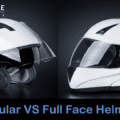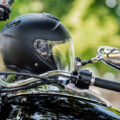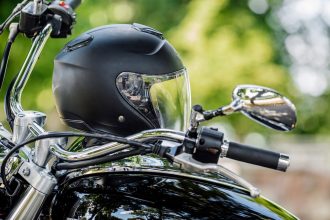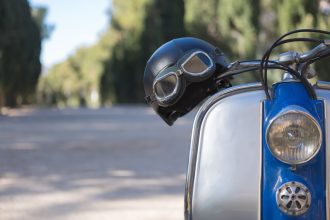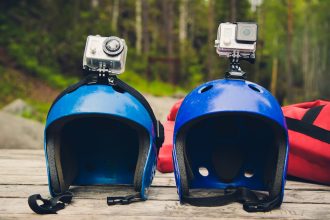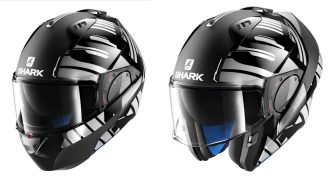“How tight should a motorcycle helmet be?” is one of the most important questions to investigate before getting on the road.
Not only are you legally responsible for ensuring you’re wearing a helmet, but it can also save your life.
In this guide, we’ll explore the various things to consider when sizing your helmet for safety.
How To Find the Right Motorcycle Helmet Fit
As a general rule of thumb, your motorcycle helmet should fit snugly without being too tight. If it’s your first time wearing one, it can be challenging to know exactly how tight it should be.
Let’s look at some fundamental fit tips to help you choose the right helmet style and size for your head.
Tip #1: Helmets Shouldn’t Move Easily
One sure-fire way to decide whether your motorcycle helmet is too loose is to shake your head when wearing it. If you find the helmet’s moving around too easily, it’s certainly not fit properly.
On the other hand, it can’t be too tight to where your cheeks feel tight. A motorcycle helmet that’s too tight can come off in an accident, move around inadvertently when driving, or be exceptionally noisy.
If you notice you can barely hear anything when riding due to air passing through the motorcycle helmet, it’s likely too loose.
Tip #2: Inspect the Pressure Points
Did you know motorcycle helmets are designed with specific pressure points?
These points help hold the helmet in place when it’s on your head, preventing movement. If the pressure points feel too tight, it’s likely your helmet isn’t fitting the way it should.
Typically, you’ll notice significantly red spots on your head or some bruising and general discomfort.
Unfortunately, when helmets are too tight, the pressure points often cause headaches. You’ll likely have to size up or choose a different helmet style in these instances.
Tip #3: Remember Padding Adapts
A commonly forgotten tip many professional motorcyclists talk about is how padding adapts over time.
On the inside of the helmet, you’ll notice cushioning that will undoubtedly adapt to the contours of your face. In fact, it’s likely that every new helmet will feel slightly uncomfortable at first but won’t cause headaches or significant redness.
Most top-tier motorcycle helmets will break in about 20% after wearing them for 20 hours. Once the padding feels the warmth of your face, the inner layers will tailor themselves to the shape of your head.
When trying on a new motorcycle helmet, consider limited discomfort as it could be expected.

How To Do Motorcycle Helmet Fit Checks
Buying a motorcycle helmet is similar to buying any other type of helmet, specifically bike helmets. You’ll want to ensure you go through some fit checks before settling on a specific brand.
This process can help you choose a helmet that correctly fits your head’s shape and size.
Let’s look at some essential steps to follow when you begin sizing your helmet.
Step #1: Measure Your Head
The first thing we recommend you do before settling on a helmet is to make sure you measure your head. Using measurements is a fantastic way to ensure you’re buying a size that’s most likely to fit.
You’ll find three different general helmet sizes riders fit into, namely intermediate, long, or round oval.
To get accurate measurements, you’ll want to use a friend’s help, as they’ll accurately be able to gather your head shape. It’s also essential to make sure nothing obstructs your measurements, so lie your hair down flat.
Using the measuring tape, measure your head’s circumference to find a generous size.
Step #2: Consider the Helmet Type
Motorcycle helmets come in many different shapes and sizes, with many being more accommodating than others.
If you find that certain helmets fit you less comfortably than others, it could be due to their general design.
Let’s browse some of the most popular styles you’re likely to find.
- Open Face Helmets: Least protective, least restrictive
Open face helmets are typically chosen by motorcyclists looking for the least restrictions with limited protection. They only cover the top of your head, making them useful for retro bikes and cruisers rather than high-speed vehicles.
- Full Face Helmet: Highly protective, great for speed
Full face helmets are undoubtedly one of the most protective helmet types as they fully cover your head. You’ll have an integrated face shield, a chin bar, and plenty of protective features. They’re also remarkable for sound isolation.
- Adventure Helmet/ADV: Street-legal, off-road-friendly
Adventure Helmets (ADVs) are a great combination of street-legal and trail-legal helmets. They have features ideal for dirt tracks with the protection needed for street biking. They’re great for ventilation and can also be worn with goggles, as they’re relatively roomy.
Step #3: Wear the Helmet
The third step is to make sure you’re wearing the helmet when checking its fit.
Take the time to adjust the chin strap to your desired position as if you were about to get onto your bike. From there, pay close attention to how the helmet fits when you look left and right and tilt your head up and down.
You’ll likely have to make some adjustments during your first wear test. Most riders adjust the chin strap, adjust their ears, and shift the helmet to sit perfectly.
If you begin to notice any significant discomfort, it’s time for larger or smaller helmet sizes.
A properly fitting helmet will sit against your cheeks, adding ample padding and pushing them up. Your chin bar should also hold your face in place, ensuring your cheeks don’t move with your head.
If you notice any sliding, try sizing down, whereas if it’s too tight, try sizing up.
How Tight Should a Motorcycle Helmet Be?
When asking, “How tight should a motorcycle helmet be?” the general answer is not too tight to where it causes discomfort.
Remember that new motorcycle helmets are bound to feel tighter than average as they adapt over time.
That said, your helmet should be tight enough to where it doesn’t shift or move as you move your head to ensure your safety while riding your motorcycle.
We hope you find this information helpful. If you would like to support this site, you can by purchasing through recommended links on the page. Should you decide to purchase, we may earn a small percentage of the sale at no cost to you.
Thank you for your support.





